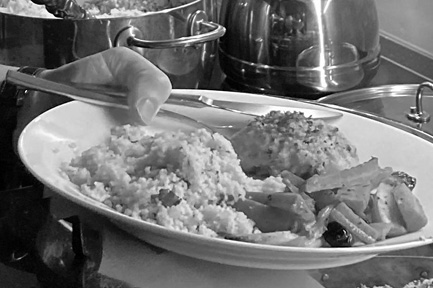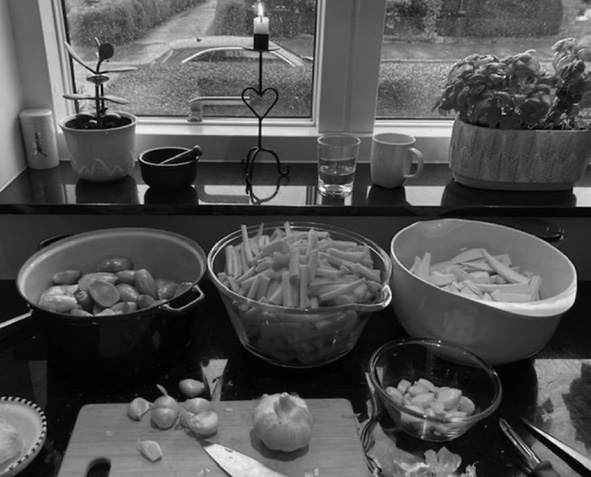Lemon chicken and roasted vegetables with cumin-scented couscous
As relative newcomers to Lund, Sweden, my husband and I have scrambled to set up our household and especially our kitchen. Thanks to Facebook Marketplace, secondhand stores, and IKEA, we’ve collected cookware, baking dishes, pans, serving bowls, utensils, and a few small appliances. Our Swedish apartment and its kitchen are slowly coming together.
However, if there’s an operative word we use a lot since moving to Sweden, it is flexibility. Especially with food preparation, we must adapt. With entirely different sized pans, switching to metric measurements and temperatures, shopping at food markets foreign to me with ingredient labels written in a language I am still learning, cooking on induction instead of gas, and having just one small oven, it’s imperative to stay limber and keep learning. This fall we met apple varieties we’ve never heard of. Bitter almonds replace almond extract and chopped chocolate bars stand in for chocolate chips. Fish varieties are different, so are sausages, dairy products, types of flour, and the consistency of sugar. And I have yet to meet a Swede who has heard of cream of tartar or celery seed.

Mind you, I am not complaining. I’m grateful for a fantastic kitchen, abundant high quality food supplies and loads of fresh, locally grown produce. But I’m still seeking ease and comfort in a somewhat unfamiliar food milieu. Ironically, I grew up claiming I was half Swedish and half Danish, but here in Sweden I feel less secure preparing dishes that I used to consider simple go-to meals. I guess I’m more American than I realized.
Recently while planning dinner for 20 guests, I decided to make a family favorite; lemon chicken with roasted root vegetables and olives. It’s simple and delicious especially when accompanied by cumin scented couscous. This dish works best using bone-in chicken breasts with skin. With the menu planned and a list in hand I headed out to shop. Imagine my shock when four different butchers confirmed that bone-in chicken breasts are not available in this country. The only way to procure this cut of poultry is to purchase the whole bird. But buying 20 chickens was out of the question!
Once again, it was time to modify and not give up because of homesickness or frustration over chicken breasts. After a helpful video chat with a couple of dear friends in the U.S.; former work colleagues and brilliant chefs, I took their advice and tackled a more time-consuming method using boneless skinless chicken breasts. As I bathed a pile of them in sour cream mixed with Dijon mustard, to chill overnight, I thought about what it means to be open to change. I must adjust and allow circumstances to help me stretch and grow. Everything can’t stay the same as it was before. It’s similar to what we discuss with one of our churches here in Sweden; we must change or die.
The next day I rolled each chicken breast in breadcrumbs mixed with Dijon, lemon zest, smashed garlic, chopped thyme, parsley, pepper, and a combination of melted butter and olive oil. This promises moist chicken if it’s baked just to an internal temperature of 163-165 degrees F. The goal is no shoe-leather chicken like we’ve all endured at way too many banquets.
The adjustments deemed necessary by missing or different ingredients are the impetus to stay nimble and “figure it out.” It might sound ridiculous, but these cooking challenges are what keep me awake at night pondering how to proceed. Mostly I want our guests to be well-fed and well cared for, as I strive to become more comfortable cooking here. I realize we didn’t move to a place that’s so unlike the United States. Imagine if we’d landed in Botswana or Nepal! Perhaps that’s why the differences have been surprising. I didn’t anticipate them.
As I prepared the meal, I had plenty of time to consider our guests, many of whom came to Lund for its university. They hail from India, Indonesia, Dubai, France, Iran, South Korea, The Netherlands, Spain, Germany, Sweden, and the United States. Talk about missing the comforts of familiar foods! These are brave souls; some who have traveled halfway around the globe to study or work. They miss foods that I don’t have a clue how to make. I look forward to learning from them. Then I’ll have an even greater need to flex, learn and lean on God as I cook and live in a place that is lovely, but not quite home.
LEMON CHICKEN AND ROASTED ROOT VEGETABLES
(Original U.S. version)
8 bone-in, skin-on chicken thighs or four bone-in, skin-on chicken breasts, halved
3 T. olive oil
1 lemon, zested and juiced; juice and zest kept separately
8 cloves garlic, peeled
8 large shallots, peeled and halved
About 1½ lbs. julienned root vegetables such as carrots, parsnips or turnips
2 T. fresh thyme leaves
½ cup dry white wine
1 cup kalamata olives
Preheat oven to 475 degrees F.
Rub chicken with 1 T. olive oil and season well with salt and pepper. Place chicken pieces on a baking sheet. In a large bowl, toss cut vegetables with 2 T. olive oil, garlic, shallots, lemon zest, thyme, salt and pepper. Arrange vegetables around chicken pieces. Roast until the chicken is golden brown—about 40-45 minutes. (Watch carefully. The goal is sizzling chicken, not sputtering or smoking.) Remove pan from oven and pour wine and lemon juice over. Add olives. Run a stiff spatula under everything, scraping up the tasty browned bits, mingling them with the chicken and vegetables. Return to the oven and continue to roast until the liquid has reduced and thickens slightly—about 15 minutes. If the pan looks dry at any point add a little more wine. Serve hot with cumin couscous.

Cumin-scented couscous
1 cup quick cooking couscous
2 T. unsalted butter
2 shallots, peeled and minced
1 tsp. ground cumin
½ tsp. crushed fennel seeds
1¼ cups low-sodium chicken broth, (homemade or purchased)
3 T. minced flat leaf parsley
Place the couscous in a medium sized bowl. Set aside.
Melt butter in a saucepan over medium heat. Add shallots, cumin and fennel. Cook stirring until shallots are translucent. About 2-3 minutes. Add the broth and salt to taste. Bring to a boil.
Pour simmering broth over couscous, stir and cover tightly with plastic wrap. Allow couscous to absorb the liquid — about 8-10 minutes.
Remove the plastic, add the parsley and fluff with a fork. Serve hot.
Serves 4-5
